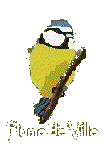Plume de Ville
From day to day.
°°°°°°°°°°°°°°°°°°°°°°° °
March 2009
March 1st
March begins again in the clouds. 10 °
28
February. Superb spring sun, the last day of February. Around noon a
blue tit arrives. A few seconds later another joined the blue tit. She
descends to the nest box and the other flies off.
The first
comes in the nestbox without much hesitation. It is noon. The visit
will be short: a few seconds.



March 2
Sunshine and blue sky. 12 °
Visit from two today.
A blue tit arrives, waits for. A second joined the first.
The first, probably the male, tail erect, wings lowered,
leaps to
the nest, goes to the entry, he returns to the second tit with the same
pantomime, goes down to the nest box at the entrance. Clearly show the
way, did you see what I found?. The other tit looks at from above. Come
see! Well, its girlfriend for the moment does not seem much interested,
she flies off followed immediately by the male. Go perseveres friend!
The next might be the right one. They both come back several times.
Sittelle torchepot. Wood
Nuthatch
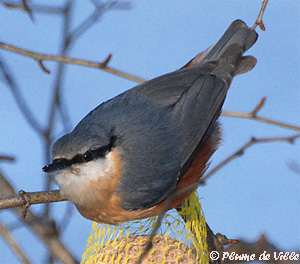
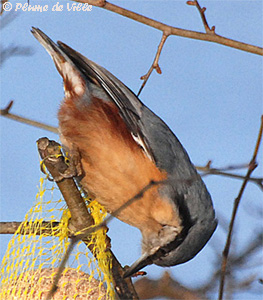 [Sitta
europaea
-
[Sitta
europaea
-
Passériformes- Sittidés]
Wood Nuthatch
As the woodpeckers (the name
"Sitté " means
woodpecker in Greek) this beautiful bird can hide his food in a
crevasse. He hammers out it and he breaks it with noisy blows, (but
it's not a woodpecker, it is of a different order)
We can see it normally in the process of browsing the trunks
and
branches in all directions often upside down, as I have presented here.
It clings to the trunk with a curled finger. This one, photographed in
early January at Vincennes, tries to break the hardened fat ball. Ideal
time for the photo. It nests in a tree hole or a crevasse, or a nest
box but begins the building with a mixture of mud and saliva to reduce
the size, just of the size of the bird, to protect her brood of larger
birds. It is not "Torchepot" for nothing! (In French "torchepot" means
"wipes a pot".)
It is the size of a great tit (14cm).
March 7
A visit to the nest box.
In the afternoon, a blue tit sings
perched in the willow. And by chance I see a second blue out of the
nest box! No pictures, I have not checked the camera and it was too
dark to get a good photo.
March 8
This morning very dark and rainy, 10 °. A little light
in the afternoon.
One (or "the" blue?) blue comes regularly every day. At least, we see
it at least once in the day.
Long runway mandatory ...
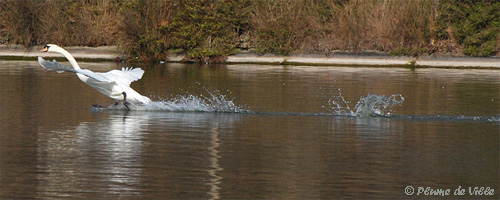
For the Mute Swan.

And for the Great Cormorant..
Grand Cormoran. [Phalacrocorax
carbo -
Pélécaniformes phalacrocoracidés ]
Great Cormorant
Spring wedding dress for cormorants displaying a tuft of white feathers
on the thigh.
March 10
Overcast, light rain in the morning, 5 °. A little
warm in the afternoon. 10 °
Output of the first
bumblebees.
It must say "I like hot sun", it is still numb and wet this morning.
It is probably a Large Earth Bumblebee or Buff-tailed Bumblebee [Bombus terrestris]. The Large Earth Bumblebee are among the first to go out in March.
In french, it is called "white ass", is from the family of bees such as honeybees. (They are characterized by their white-ended abdomens.).
Females (queens) build a new nest, a hole in the floor that will
house the new colony, each year. They alone have spent the winter and
emerge in spring.Tthe queen is the only bumblebee to hibernate through
the winter
The settlement will house male and female and workers. Only females can
sting.
These bumblebees are used in greenhouses as pollinators.
http://www.bumblebee.org/terr.htm
http://champignon.champyves.free.fr/FicsHtml/I_BourdonTerrestre.htm
http://aramel.free.fr/INSECTES18-4.shtml
http://papylou.lalibreblogs.be/archive/2007/11/23/bourdon-terrestre.html
http://en.wikipedia.org/wiki/Bombus_terrestris
March 13
March 11: Visit and inspection at the door, just one blue tit.
March 12: Two new inspections for a while.
March 13: two blue tits arrive. The first inspects the
entrance a
few moments. Then the other comes to his turn to hang on the entrance
and finally she comes in for a few seconds. They leave together.
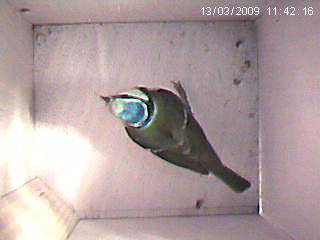
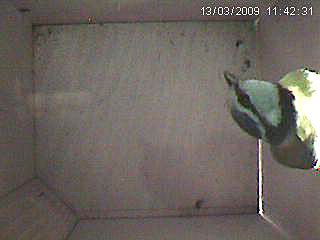
Visit of another blue...
A small shower and a spring-cleaning ...Oxychilus can slide, a land snail, family zonitidae ( "glass snails"), a snail wetlands. It has a dark blue body and a flattened shell, translucent, fine, bright, orange-brown, 1cm.
Helveticus likely because of his dark band on its shell. It emits a faint odor ... garlic (no, that must not give you ideas ...) like other members of his family
http://www.gireaud.net/especes.htm
http://aramel.free.fr/INSECTES56.shtml
March 15
30 mars
Le printemps est arrivé mais peu de
nouveauté
côté mésanges, la caméra a
détecté quatre fois un
regard à la porte mais
c'est tout. Une bleue solitaire passe mais plus pour chanter
en haut du bouleau.
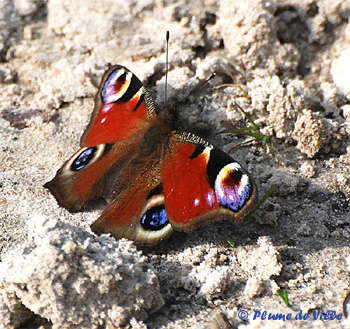
Ce magnifique papillon est un Paon du jour, Inachis io (Vanesse io) (Peacock). Famille des nymphalidés. 5 cm
Il hiverne à l'état adulte et sort d'hivernage en mars. Ceux-ci viennent de sortir en forêt. Les couleurs sont moins vives qu'en fin d'été. C'est la génération de fin août qui hiverne. Posés sur le chemin, ils essayent de récupérer le maximum de chaleur.
C'est une "Vanesse" à la chenille noire et pleine d'épines.Lui aussi sort d'hivernage, c'est Robert-le-Diable [Polygonia c-album -Nymphalidés-]. Encore nommé Gamma ou C-Blanc.
Il se chauffe lui aussi au soleil an compagnie des Paons du Jour.
Comme ce dernier il affectionne les orties.
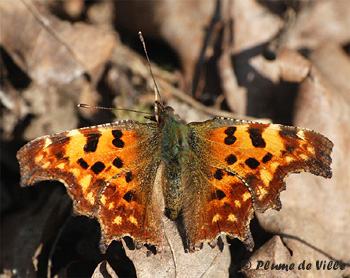
Revers des ailes du papillon où on distingue son "C" blanc sur l'aile postérieure qui lui a valu son nom de C-album.
Photo de juin 2008, occupé à se réchauffer ceux de cette année n'ont pas voulu me montrer leur revers.
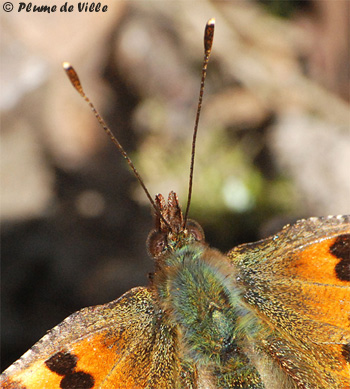
"Robert-le-Diable" se laisse approcher de
très près et n'est pas impressionné
par les gros plans.
Et permet d'admirer son antenne bien joliment
décorée.
Son collègue d'hivernage le Paon du Jour, par
contre, a une bonne vue et il est impossible de l'approcher. On a beau
ruser, rien
à faire, à quatre mètres, il fuit,
pour
se reposer quelques instants plus tard, presque au même
endroit.
(Forêt
Seine et Marne 17 mars 2008)
